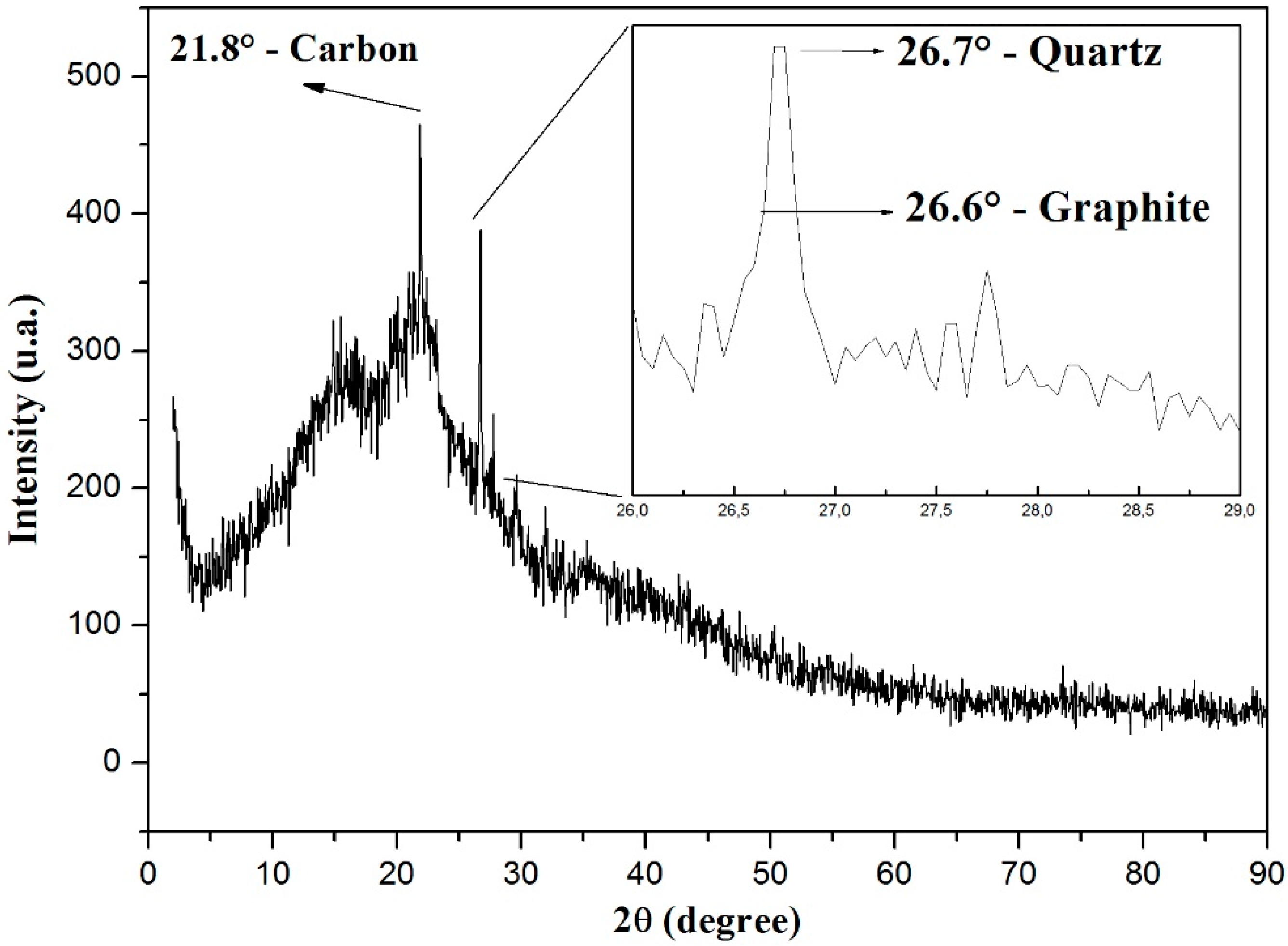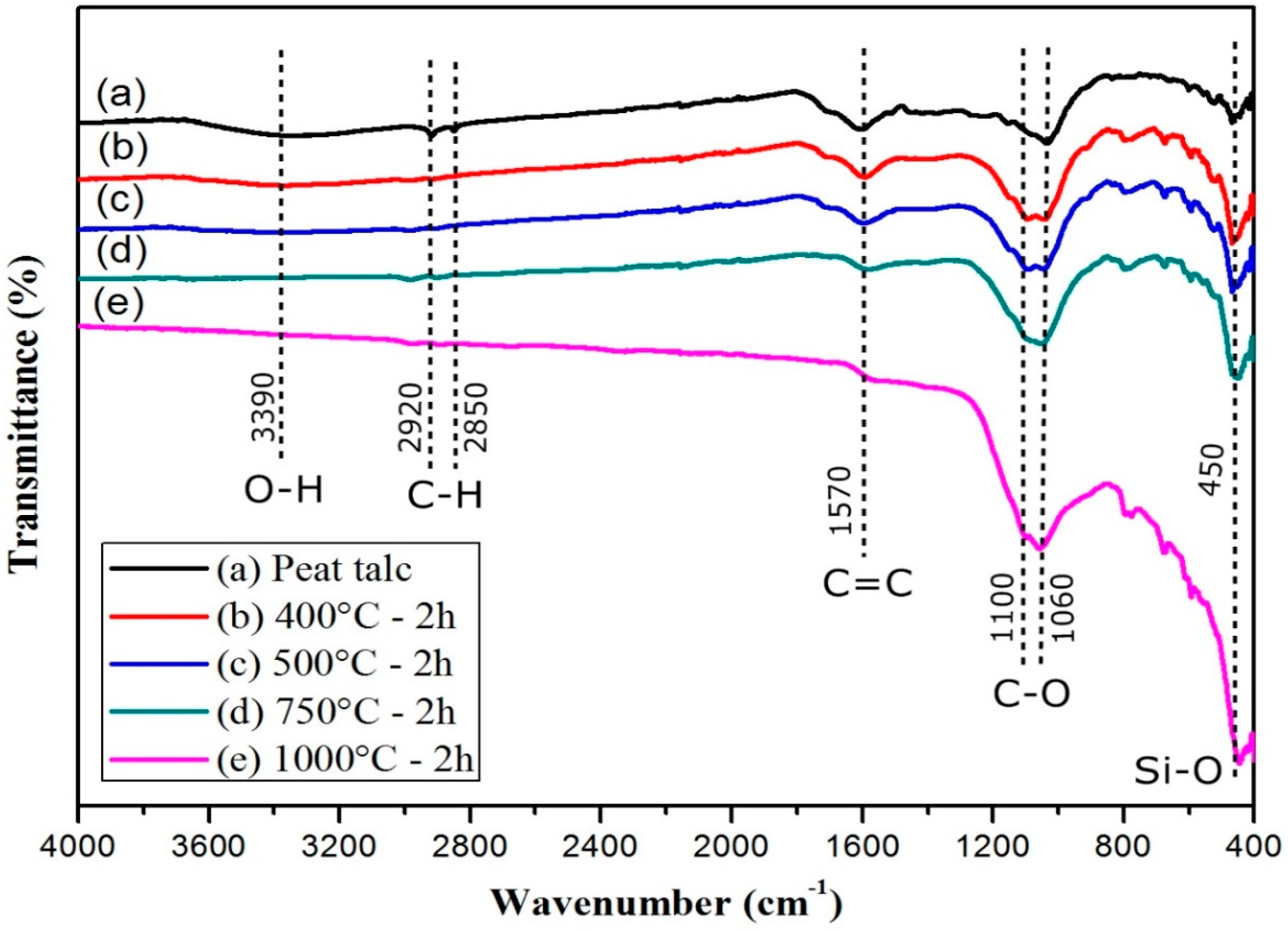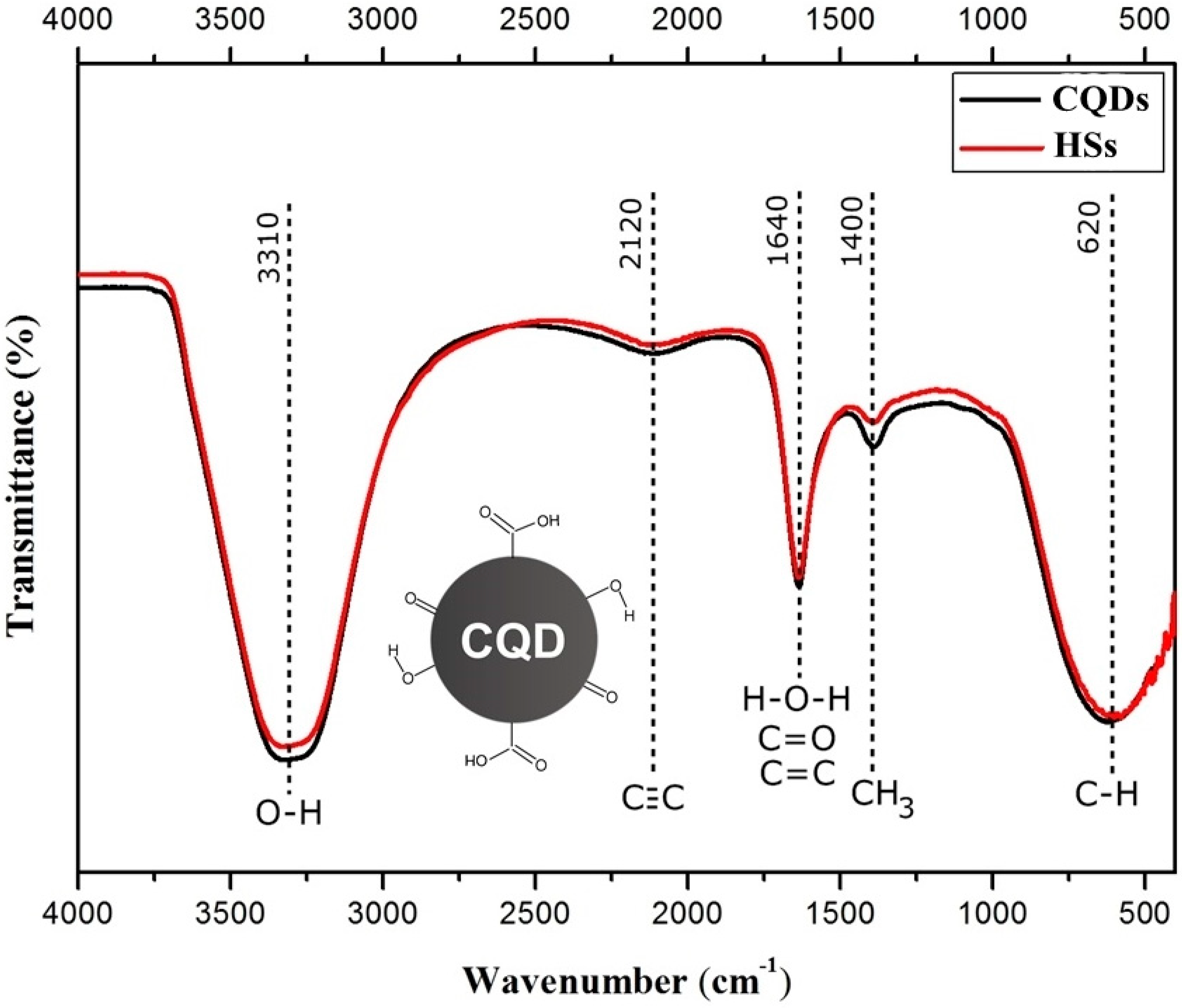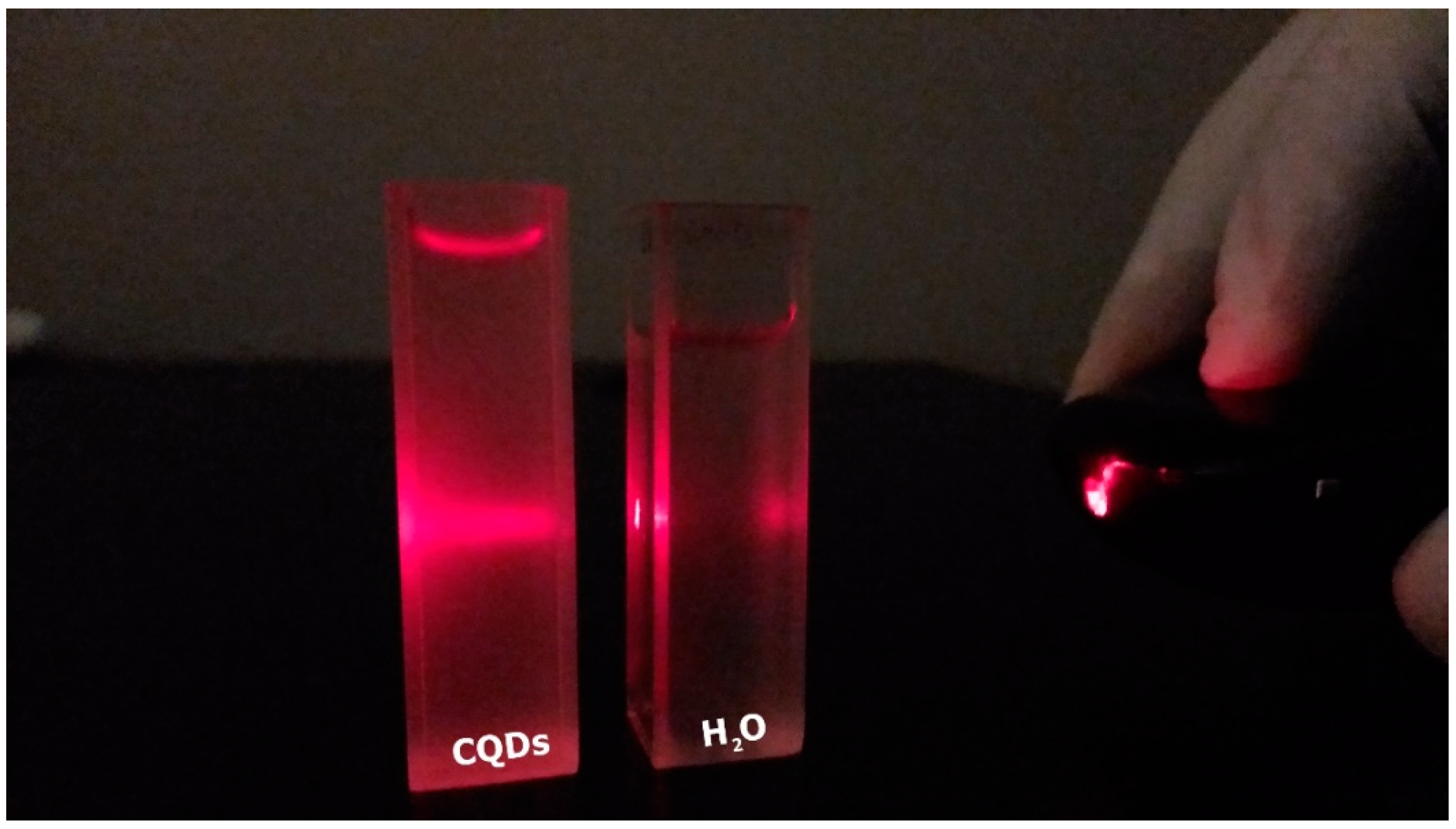An Alternative Route to Obtain Carbon Quantum Dots from Photoluminescent Materials in Peat
Abstract
:1. Introduction
2. Experimental Section
2.1. Materials and Methods
2.2. Extraction of Fluorescent Humic Substances from Peat (Route I)
2.3. Synthesis of Carbon Quantum Dots (Route II)
3. Results and Discussion
3.1. XRD
3.2. Raman Spectroscopy
3.3. FTIR
3.4. Absorption Spectroscopy (UV-Vis) and Photoluminescence Spectroscopy (PL)
3.5. High-Resolution Transmission Electron Microscopy
4. Conclusions
Author Contributions
Funding
Conflicts of Interest
References
- Mulvaney, P. Nanoscience vs. Nanotechnology—Defining the Field. ACS Nano 2015, 9, 2215–2217. [Google Scholar] [CrossRef] [PubMed]
- Mansur, H.S. Quantum dots and nanocomposites. WIREs Nanomed. Nanobiotechnol. 2010, 2, 113–129. [Google Scholar] [CrossRef] [PubMed]
- Mansur, H.S.; Mansur, A.A.P.; González, J.C. Synthesis and characterization of CdS quantum dots with carboxylic-functionalized poly (vinyl alcohol) for bioconjugation. Polymer 2011, 52, 1045–1054. [Google Scholar] [CrossRef] [Green Version]
- Machado, C.E.; Vieira, K.O.; Ferrari, J.L.; Schiavon, M.A. Pontos Quânticos de Carbono: Síntese Química, Propriedades e Aplicações. Rev. Virtual Quim. 2015, 7, 1306–1346. [Google Scholar] [CrossRef]
- Kagan, C.R.; Fernandez, L.E.; Gogotsi, Y.; Hammond, P.T.; Hersam, M.C.; Nel, A.E.; Penner, R.M.; Willson, C.G.; Weiss, P.S. Nano Day: Celebrating the Next Decade of Nanoscience and Nanotechnology. ACS Nano 2016, 10, 9093–9103. [Google Scholar] [CrossRef] [PubMed]
- Ahmadian-Fard-Fini, S.; Salavati-Niasari, M.; Safardoust-Hojaghan, H.J. Hydrothermal green synthesis and photocatalytic activity of magnetic CoFe2O4–carbon quantum dots nanocomposite by turmeric precursor. Mater. Sci. Mater. Electron. 2017, 28, 16205–16214. [Google Scholar] [CrossRef]
- Wang, Y.; Hu, A. Carbon quantum dots: Synthesis, properties and applications. J. Mater. Chem. C 2014, 2, 6921–6939. [Google Scholar] [CrossRef]
- Li, H.; Kang, Z.; Liu, Y.; Lee, S.-T. Carbon nanodots: Synthesis, properties and applications. J. Mater. Chem. C 2012, 22, 24230–24253. [Google Scholar] [CrossRef]
- Kan, H.; Liu, S.; Xie, B.; Zhang, B.H.; Jiang, S.L. The effect of Au nanocrystals applied in CdS colloidal quantum dots ultraviolet photodetectors. J. Mater. Sci. Mater. Electron. 2017, 28, 9782–9787. [Google Scholar] [CrossRef]
- Shi, H.; Wei, J.; Qiang, L.; Chen, X.; Meng, X. Fluorescent Carbon Dots for Bioimaging and Biosensing Applications. J. Biomed. Nanotechnol. 2014, 10, 2677–2699. [Google Scholar] [CrossRef] [PubMed]
- Atabaev, T.S. Doped Carbon Dots for Sensing and Bioimaging Applications: A Minireview. Nanomaterials 2018, 8, 342. [Google Scholar] [CrossRef] [PubMed]
- Zhu, S.; Meng, Q.; Wang, L.; Zhang, J.; Song, Y.; Jin, H.; Zhang, K.; Sun, H.; Wang, H.; Yang, B. Highly photoluminescent carbon dots for multicolor patterning, sensors, and bioimaging. Angew. Chem. Int. Ed. Engl. 2013, 52, 3953–3957. [Google Scholar] [CrossRef] [PubMed]
- Li, H.; He, X.; Kang, Z.; Huang, H.; Liu, Y.; Liu, J.; Lian, S.; Tsang, C.H.A.; Yang, X.; Lee, S.-T. Water-soluble fluorescent carbon quantum dots and photocatalyst design. Angew. Chem. Int. Ed. 2010, 49, 4430–4434. [Google Scholar] [CrossRef] [PubMed]
- Gupta, V.; Chaudhary, N.; Srivastava, R.; Sharma, G.D.; Bhardwaj, R.; Chand, S. Luminscent graphene quantum dots for organic photovoltaic devices. J. Am. Chem. Soc. 2011, 133, 9960–9963. [Google Scholar] [CrossRef] [PubMed]
- Liu, X.; Pang, J.; Xu, F.; Zhang, X. Simple approach to synthesize amino-functionalized carbon dots by carbonization of chitosan. Sci. Rep. 2016, 6, 31100. [Google Scholar] [CrossRef] [PubMed]
- Lim, S.Y.; Shen, W.; Gao, Z. Carbon quantum dots and their applications. Chem. Soc. Rev. 2015, 44, 362–381. [Google Scholar] [CrossRef] [PubMed]
- Dimos, K. Carbon quantum dots: Surface passivation and functionalization. Curr. Org. Chem. 2016, 20, 682–695. [Google Scholar] [CrossRef]
- Canellas, L.P.; Santos, G.A. Humosfera: Tratado Premilinar Sobre a Química das Substâncias Húmicas/Luciano Pasqualoto Canellas e Gabriel Araújo Santos; Universidade Estadual do Norte Fluminense: Rio de Janeiro, Brazil, 2005. [Google Scholar]
- Delicato, D.M.S. Physical-Chemical Properties and Sorption Characteristics of Peat. Ph.D. Thesis, Dublin City University, Dublin, Ireland, July 1996. [Google Scholar]
- Ribeiro, N.C. Uso da Turfa Como Material Alternativo na Formação de Componentes Eletrônicos de Baixo Custo; Universidade de Brasília: Brasília, Brazil, 2012; p. 88. [Google Scholar]
- Sandri, G.L.; Ribeiro, N.C.; Romariz, A.R.; Ceschin, A.M. Electrical and humidity characterization of humic substances (HS) from peat for a possible use in humidity sensing. ECS Trans. 2010, 31, 419–424. [Google Scholar]
- Da Cunha, W.F.; Ribeiro, N.C.; Pereira, N.S.; Sandri, G.L.; Ceschin, A.M. Humin based ammonia sensor: Characterization and performance analysis. J. Mater. Sci. Mater. Electron. 2016, 27, 3039–3047. [Google Scholar] [CrossRef]
- Dong, Y.; Wan, L.; Cai, J.; Fang, Q.; Chi, Y.; Chen, G. Natural carbon-based dots from humic substances. Sci. Rep. 2015, 5, 10037. [Google Scholar] [CrossRef] [PubMed]
- Carvalho, C.L.D. Deposição e Propriedades Eletroquímicas de Filmes de Polianilina/óxido de Grafeno; Universidade de Brasília: Brasília, Brazil, 2016. [Google Scholar]
- Ferrari, A.C.; Robertson, J. Interpretation of Raman spectra of disordered and amorphous carbon. Phys. Rev. B 1999, 61, 20. [Google Scholar] [CrossRef]
- Morais, D.R.P.; Delgado, C.O.B.; Mota, A.L.N.; Santiago, R.C. Caracterização de turfa e vermiculita hidrofobizadas por espectroscopia de absorção na região do infravermelho-FTIR. Blucher Chem. Proc. 2015, 3, 1140–1147. [Google Scholar]
- Silverstein, R.M.; Webster, F.X. Identificação Espectrométrica de Compostos Orgânicos, 7th ed.; Editora LTC: Rio de Janeiro, Brazil, 2006. [Google Scholar]
- Ke, J.; Li, X.; Zhao, Q.; Liu, B.; Liu, S.; Wang, S. Upconversion carbon quantum dots as visible light responsive component for efficient enhancement of photocatalytic performance. J. Colloid Interface Sci. 2017, 496, 425–433. [Google Scholar] [CrossRef] [PubMed]












© 2018 by the authors. Licensee MDPI, Basel, Switzerland. This article is an open access article distributed under the terms and conditions of the Creative Commons Attribution (CC BY) license (http://creativecommons.org/licenses/by/4.0/).
Share and Cite
Souza da Costa, R.; Ferreira da Cunha, W.; Simenremis Pereira, N.; Marti Ceschin, A. An Alternative Route to Obtain Carbon Quantum Dots from Photoluminescent Materials in Peat. Materials 2018, 11, 1492. https://doi.org/10.3390/ma11091492
Souza da Costa R, Ferreira da Cunha W, Simenremis Pereira N, Marti Ceschin A. An Alternative Route to Obtain Carbon Quantum Dots from Photoluminescent Materials in Peat. Materials. 2018; 11(9):1492. https://doi.org/10.3390/ma11091492
Chicago/Turabian StyleSouza da Costa, Rafael, Wiliam Ferreira da Cunha, Nizamara Simenremis Pereira, and Artemis Marti Ceschin. 2018. "An Alternative Route to Obtain Carbon Quantum Dots from Photoluminescent Materials in Peat" Materials 11, no. 9: 1492. https://doi.org/10.3390/ma11091492
APA StyleSouza da Costa, R., Ferreira da Cunha, W., Simenremis Pereira, N., & Marti Ceschin, A. (2018). An Alternative Route to Obtain Carbon Quantum Dots from Photoluminescent Materials in Peat. Materials, 11(9), 1492. https://doi.org/10.3390/ma11091492




